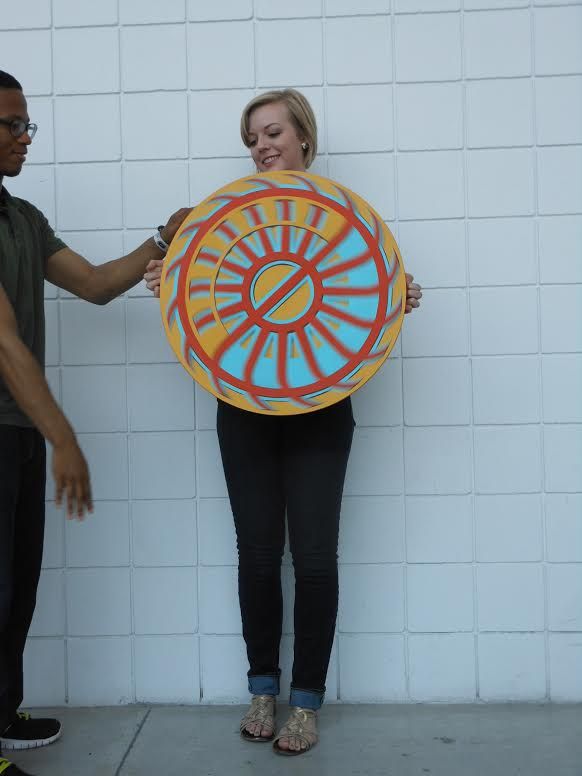ISU professor extends artistic views across Iowa
September 4, 2015
One professor in the College of Design is using art to assist communities in reinventing themselves.
Jennifer Drinkwater, assistant professor of art and visual culture and community art extension specialist, serves as an aid to communities in Iowa looking to advance the amount of art in their areas.
“Half of my time is spent serving the students of the university, and the other half is serving the people of Iowa.” Drinkwater said.
Being the first land-grant university in the United States, Iowa State has a long history of extension outreach. Every county in the state has at least one extension office, meaning there are at least 99 in the state.
“The extensions basically serve as a bridge between the resources and the research and knowledge that the university deals with and how to disseminate those into communities all over Iowa,” she said.
Iowa State has one of the largest university public art collections in the nation, thanks to its eighth president of the university, Raymond Hughes. In 1933, during the height of the Great Depression, Hughes did the unexpected.
“A lot of the time when you’re suffering from financial hardship, departments get cut,” Drinkwater said. “Funding gets cut, especially to the arts.”
This was not the case for the university. Hughes decided to invest in the arts, starting the public art collection, an artist-in-residency program and establishing art as part of the curriculum at Iowa State.
The history of extension outreach combined with the university’s history of seeing art as valuable has uncovered the need for Drinkwater’s position, a position that was around several decades ago but lost due to funding cuts.
“There are a lot of artists all over the nation, a lot of communities all over the nation, who see art as a really important vehicle for community and economic development,” Drinkwater said. “So that is what I hope to explore in this job.”
Starting in July, Drinkwater began visiting communities that reached out to her for a variety of reasons. Communities may wish to use art to explain their history, attract visitors or to combat dire issues. In Waverly, Iowa, for example, artists are working to raise awareness of hunger and food scarcity.
“They tell me specifics about what they’re dealing with, and I help them think about different ways to approach a concern,” Drinkwater said.
While people from all over Iowa have recently been reaching out to her, Drinkwater’s work in Perry, Iowa, best showcases what she hopes to accomplish.
She and the ISU Print Club worked with anyone in Perry who wished to participate on a steamroller print project, specifically targeting a high school class and local art center. Each participant was given a wooden block to carve their own idea of “Portraits of Perry.”
“It was a great way of bringing the people together and creating art,” Drinkwater said of the event.
Also in Perry, Drinkwater and Ingrid Lilligren, professor of art and visual culture and chairwoman of the department, worked together to complete a mural installation project on the bike trail.
“She’s a fantastic colleague,” Lilligren said. “[Drinkwater] has excellent ideas, she listens very well to what the needs are.”
The building in question gives passerby a feel of Perry and houses a local bicycle co-op that gives bicycles to low-income families.
The murals were implemented by students from the College of Design. Each student was given a small amount of space and the ability to do with it what they chose after speaking to residents and sitting with the Perry City Council.
The timing couldn’t have been more perfect; it was completed right before RAGBRAI, the six-day bicycle ride across Iowa.
“We had a plaque on the building that explained how it had come to be,” Lilligren said, “which raises the visiblity of what design can do in communities. It gives a tremendous boost to the university.”
Another mural is to be funded by an American Library Association and National Endowment for the Humanities grant for the PBS series, “Latino Americans: 500 Years in History.” The grant will fund six different cultural projects, one being the mural in question. Jon Wolseth, community development specialist, is also assisting with the project.
“I’m really excited to be collaborating with her,” Wolseth said.
The project is currently in planning as Wolseth collects stories of immigration, but it will eventually depict oral histories of the Latino population in Perry. However, the location has yet to be named.
“I think the reason Perry has been really great to work with is they are so supportive of art and creativity,” Drinkwater said. “They have wonderful city administrators who see art as valuable and wonderful business owners who invest in art.”
Perry’s collaboration with Drinkwater is beneficial not just for the art community, but for the town as well.
“People want to go to places that have things going on,” Drinkwater said. “It encourages younger people or families to move there because there’s stuff to do.”
One idea Drinkwater has is to assemble community artist toolkits. These “toolkits” would include the information a community would need to move forward with planning, such as a series of questions to consider regarding their own culture.
“It’s kind of like the first step,” Drinkwater said.
Drinkwater’s toolkits could be the key to getting other Iowa communities thinking about how to portray themselves, and their personality, through art.

















